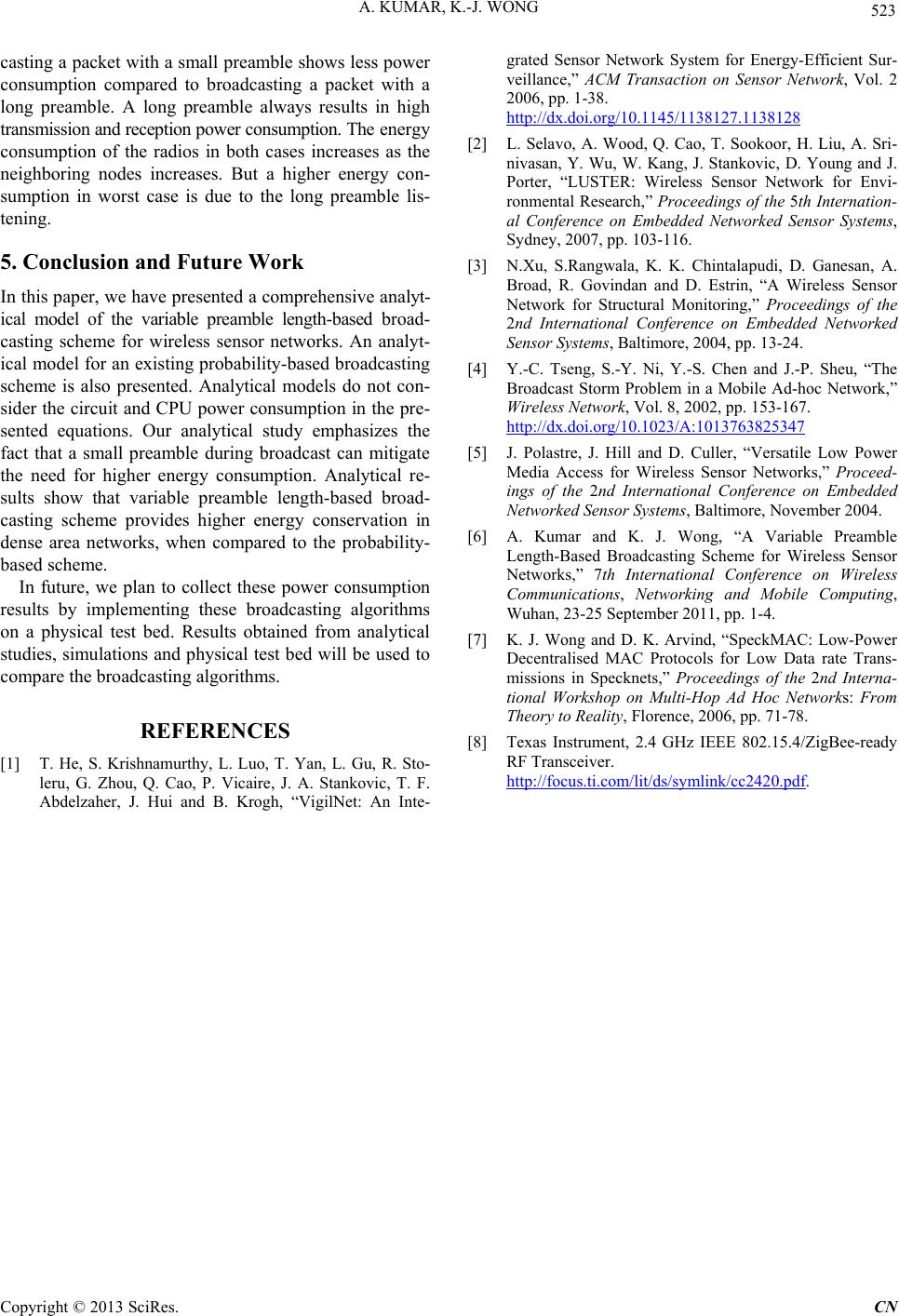
A. KUMAR, K.-J. WONG
Copyright © 2013 SciRes. CN
casting a packet with a small preamble shows less power
consumption compared to broadcasting a packet with a
long preamble. A long preamble always results in high
transmission and reception power consumption. The energy
consumption of the radios in both cases increases as the
neighboring nodes increases. But a higher energy con-
sumption in worst case is due to the long preamble lis-
tening.
5. Conclusion and Future Work
In this paper, we have presented a comprehensive analyt-
ical model of the variable preamble length-based broad-
casting scheme for wireless sensor networks. An analyt-
ical model for an ex isting probability-based broadcasting
scheme is also presented. Analytical models do not con-
sider the circuit and CPU power consumption in the pre-
sented equations. Our analytical study emphasizes the
fact that a small preamble during broadcast can mitigate
the need for higher energy consumption. Analytical re-
sults show that variable preamble length-based broad-
casting scheme provides higher energy conservation in
dense area networks, when compared to the probability-
based scheme.
In future, we plan to collect these power consumption
results by implementing these broadcasting algorithms
on a physical test bed. Results obtained from analytical
studies, simulations and physical test bed will be used to
compare the broadcasting algorithms.
REFERENCES
[1] T. He, S. Krishnamurthy, L. Luo, T. Yan, L. Gu, R. Sto-
leru, G. Zhou, Q. Cao, P. Vicaire, J. A. Stankovic, T. F.
Abdelzaher, J. Hui and B. Krogh, “VigilNet: An Inte-
grated Sensor Network System for Energy-Efficient Sur-
veilla nc e,” ACM Transaction on Sensor Network, Vol. 2
2006, pp. 1-38.
http://dx.doi.org/10.1145/1138127.1138128
[2] L. Selavo, A. Wood, Q. Cao, T. Sookoor, H. Liu, A. Sri-
nivasan, Y. Wu, W. Kang, J. Stankovic, D. Young and J.
Porter, “LUSTER: Wireless Sensor Network for Envi-
ronmental Research,” Proceedings of the 5th Internation-
al Conference on Embedded Networked Sensor Systems,
Sydney, 2007, pp. 103-116.
[3] N.Xu, S.Rangwala, K. K. Chintalapudi, D. Ganesan, A.
Broad, R. Govindan and D. Estrin, “A Wireless Sensor
Network for Structural Monitoring,” Proceedings of the
2nd International Conference on Embedded Networked
Sensor Systems, Balt imore, 2004, pp. 13-24.
[4] Y.-C. Tseng, S.-Y. Ni, Y.-S. Chen and J.-P. Sheu, “The
Broadcast Storm Problem in a Mobile Ad-hoc Network,”
Wireless Networ k , Vol. 8, 2002, pp. 153-167.
http://dx.doi.org/10.1023/A:1013763825347
[5] J. Polastre, J. Hill and D. Culler, “Versatile Low Power
Media Access for Wireless Sensor Networks,” Proceed-
ings of the 2nd International Conference on Embedded
Networked Sensor Systems, Baltimore, November 2004.
[6] A. Kumar and K. J. Wong, “A Variable Preamble
Length-Based Broadcasting Scheme for Wireless Sensor
Networks,” 7th International Conference on Wireless
Communications, Networking and Mobile Computing,
Wuhan, 23-25 September 201 1, pp. 1-4.
[7] K. J. Wong and D. K. Arvind, “SpeckMAC: Low-Power
Decentralised MAC Protocols for Low Data rate Trans-
missions in Specknets,” Proceedings of the 2nd Interna-
tional Workshop on Multi-Hop Ad Hoc Networks: From
Theory to Reali ty, Florence, 2006, pp. 71-78.
[8] Texas Instrument, 2.4 GHz IEEE 802.15.4/ZigBee-ready
RF Transceiver.
http://focus.ti.com/lit/ds/symlink/cc2420.pdf.